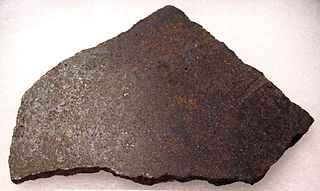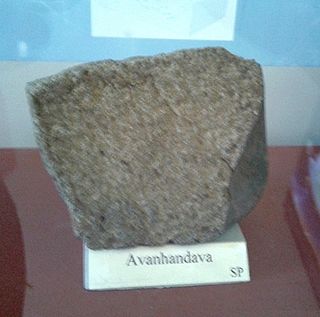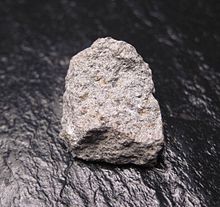
A chondrule is a round grain found in a chondrite. Chondrules form as molten or partially molten droplets in space before being accreted to their parent asteroids. Because chondrites represent one of the oldest solid materials within the Solar System and are believed to be the building blocks of the planetary system, it follows that an understanding of the formation of chondrules is important to understand the initial development of the planetary system.

A chondrite is a stony (non-metallic) meteorite that has not been modified, by either melting or differentiation of the parent body. They are formed when various types of dust and small grains in the early Solar System accreted to form primitive asteroids. Some such bodies that are captured in the planet's gravity well become the most common type of meteorite by arriving on a trajectory toward the planet's surface. Estimates for their contribution to the total meteorite population vary between 85.7% and 86.2%.

The H type ordinary chondrites are the most common type of meteorite, accounting for approximately 40% of all those catalogued, 46% of the ordinary chondrites, and 44% of all chondrites. The ordinary chondrites are thought to have originated from three parent asteroids, whose fragments make up the H chondrite, L chondrite and LL chondrite groups respectively.

The ordinary chondrites are a class of stony chondritic meteorites. They are by far the most numerous group, comprising 87% of all finds. Hence, they have been dubbed "ordinary". The ordinary chondrites are thought to have originated from three parent asteroids, with the fragments making up the H chondrite, L chondrite and LL chondrite groups respectively.

The L type ordinary chondrites are the second most common group of meteorites, accounting for approximately 35% of all those catalogued, and 40% of the ordinary chondrites. The ordinary chondrites are thought to have originated from three parent asteroids, with the fragments making up the H chondrite, L chondrite and LL chondrite groups respectively.

The LL chondrites are a group of stony meteorites, the least abundant group of the ordinary chondrites, accounting for about 10–11% of observed ordinary-chondrite falls and 8–9% of all meteorite falls. The ordinary chondrites are thought to have originated from three parent asteroids, with the fragments making up the H chondrite, L chondrite and LL chondrite groups respectively. The composition of the Chelyabinsk meteorite is that of a LL chondrite meteorite. The material makeup of Itokawa, the asteroid visited by the Hayabusa spacecraft which landed on it and brought particles back to Earth also proved to be type LL chondrite.
Qidong is a L/LL5-an chondrite meteorite fallen in 1982 in China. After detonation a single individual specimen was found in the field. Other circumstances of fall and recovery were not reported.

Gao–Guenie is a H5 ordinary chondrite meteorite that fell on Burkina Faso, West Africa, on March 5, 1960. The fall was composed of many fragments and it is one of the largest observed meteorite showers in Africa to date.

Aarhus is an H chondrite meteorite that fell to earth on 2 October 1951 at 18:15 in Aarhus, Denmark. The meteor split just before the otherwise undramatic impact and two pieces were recovered. They are known as Aarhus I and Aarhus II. Aarhus I was found in the small woodland of Riis Skov, just a few minutes after impact.
Andura is an H chondrite meteorite that fell to Earth on August 9, 1939, in Maharashtra, India.
Archie is an H chondrite meteorite that fell to earth on August 10, 1932, in Archie, Missouri.
Agen is an H chondrite meteorite that fell to earth on September 5, 1814, in Aquitaine, France.
Ambapur Nagla is an H chondrite meteorite that fell to earth on May 27, 1895, in Uttar Pradesh, India.
Anlong is an H chondrite meteorite that fell to earth on May 2, 1971, in Guizhou, China.

Arbol Solo is an H chondrite meteorite that fell to earth on September 11, 1954, in the province of San Luis, Argentina.

Arroyo Aguiar is an H chondrite meteorite that fell to earth during the summer of 1950 in the province of Santa Fe, Argentina.
Assisi is an H chondrite meteorite that fell to earth at 7:00 am on May 24, 1886, in Perugia, Umbria, Italy.
Ankober is an H chondrite meteorite that fell to Earth on July 7, 1942, in Shewa, Ethiopia.

Avanhandava is an H chondrite meteorite that fell to earth in 1952 in São Paulo, Brazil.

The Ordovician meteor event was a dramatic increase in the rate at which L chondrite meteorites fell to Earth during the Middle Ordovician period, about 467.5±0.28 million years ago. This is indicated by abundant fossil L chondrite meteorites in a quarry in Sweden and enhanced concentrations of ordinary chondritic chromite grains in sedimentary rocks from this time. This temporary increase in the impact rate was most likely caused by the destruction of the L chondrite parent body 468 ± 0.3 million years ago having scattered fragments into Earth-crossing orbits, a chronology which is also supported by shock ages in numerous L chondrite meteorites that fall to Earth today. It has been speculated that this influx contributed to, or possibly even instigated, the Great Ordovician Biodiversification Event, although this has been questioned.










